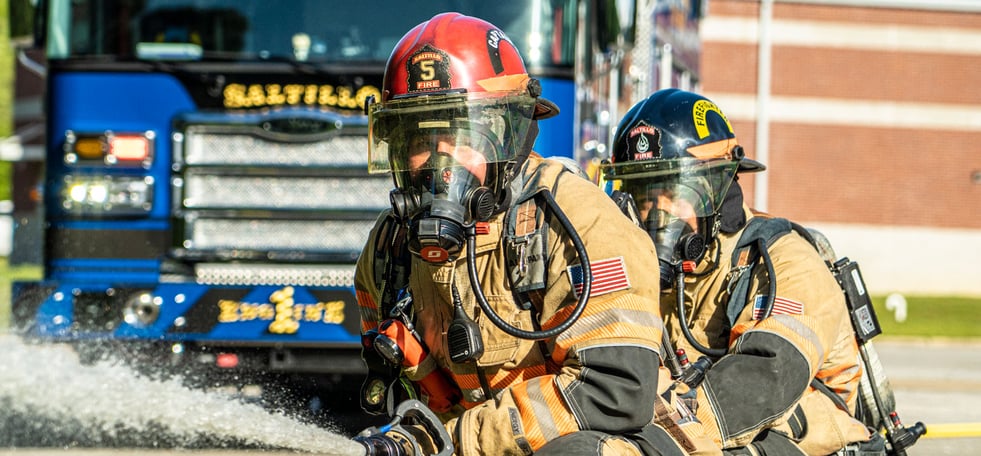
Firefighting is a complex and technical field with specialized terminology which firefighters need to know. This can be a challenge for new firefighters and those unfamiliar with the terminology of a particular type of fire truck or apparatus.
Fortunately, several online resources can help, ranging from fire apparatus terminology to general information about the field. Here’s our list of the top 19 resources available.
1. National Fire Protection Association
The National Fire Protection Association (NFPA) is a non-profit organization which develops standards for fire protection. With an overarching goal of eliminating death, injury, property damage and economic loss due to fire, and electrical and related hazards, firefighters will find this website particularly helpful in carrying out their departmental work.
Use Case: The glossary of fire terminology is one of the most comprehensive and authoritative resources available. A free download is available on the website. The NFPA also publishes more than 300 codes and standards which are adopted and used around the world. The codes and standards online resource is searchable by code, standard or keyword.
2. Pierceopedia
 Pierceopedia, a new online glossary from Pierce Manufacturing, is an alphabetic universe of fire truck terminology. Whether you're a fire service veteran or a rookie on the squad, this interactive fire truck glossary will elevate your knowledge of fire truck features, components and parts.
Pierceopedia, a new online glossary from Pierce Manufacturing, is an alphabetic universe of fire truck terminology. Whether you're a fire service veteran or a rookie on the squad, this interactive fire truck glossary will elevate your knowledge of fire truck features, components and parts.
Use Case: As one of the largest domestic customized fire and rescue apparatus manufacturers, Pierce Manufacturing knows fire trucks inside and out. This glossary is comprehensive and bookmark-worthy.
3. FireRescue1
FireRescue1 operates a network of websites covering multiple fire service aspects. It’s a reliable host for information sharing between firefighters and departments across the United States.
Use Case: Information on FireRescue1 is broad, from breaking news and coverage of pertinent fire service topics to product research and online training. It’s also an excellent source for filling in your knowledge through articles like this one you can check out when you’re done “stretchin’” on a job.
4. Glossary of Wildland Fire Terminology
This comprehensive and well-researched listing of terms and definitions was compiled by the
National Wildfire Coordinating Group (NWCG) community. Many of the terms deal with fire interaction and control in nature rather than in areas with significant human population.
Use Case: While this document is created for use by the NWCG community and its working teams to provide consistency in communications, it can also be a great resource for any department which operates or supports in areas where development is minimal.
5. Firefighting Acronyms Glossary
Time is of the essence when a department is actively working and fuels the use of acronyms. Short, sweet (but sometimes confusing) acronyms can be timesavers if everyone knows their reference.
The Pleasant Valley Fire Department of New York has a comprehensive list of acronyms which virtually any community department can use as a reference point, including common firefighting acronyms, organizations and even applicable medical terms.
Use Case: A great companion for any firefighter which deals with reporting.
6. APX Dictionary
APX Data, a provider of fire station software, has compiled a glossary of 100 important firefighting terms and definitions.
Use Case: A good resource for explorers or someone new to the field who wants to learn the basics quickly.
7. Firehouse Magazine: 400 Terms
Becoming a firefighter essentially means learning an additional language. Firehouse magazine offers a list of 400 words every firefighter should know. Regardless of whether a firefighter is part of a volunteer force, or has completed advanced fire technology training, this list offers a great benchmark for ensuring that everyone can communicate.
Use Case: This list includes several practical words which should be in every firefighter’s vocabulary and aren’t often seen in glossaries, making it an excellent tool for covering any gaps in firefighting knowledge.
8. InciWeb Terminology List
InciWeb is an inter-agency, all-risk information management system affiliated with the federal government. In addition to other features, including an interactive map showing significant incidents in the United States, the site includes a terminology list which can be accessed by scrolling or tapping on a letter.
Use Case: This terminology list is not downloadable but can be bookmarked as a reference source.
9. Glossary of Terms for the Media
When incidents occur, department representatives often are required to engage with the media. Sometimes, reporters need to learn the correct terminology to write their articles. The NFPA provides a glossary of terms specifically for use by the media.
Use Case: This is a great resource to share with your local reporter or newspaper to ensure coverage of any local incidents is accurate regarding operations, equipment, situational descriptions and even rank within a fire department.
A Detailed List of Fire Department and Government Glossaries
Several fire departments and organizational websites have already done the heavy lifting with online glossaries and helpful information. Putting this information online is a great way to share it with members of your department, as it is easily accessible and easy to update. For inspiration or information, here are some great sites to check out:
10. Maumelle Fire Department
Located in Maumelle, Arkansas, this site offers a robust online glossary created to help define local terminology.
11. Amagansett Fire Department
This Eastern New York Fire Department’s comprehensive website includes a glossary which can be downloaded as a PDF.
12. City of San Antonio
Firefighting is typically a municipal service requiring communication crossover with government entities. The City of San Antonio has created a helpful and concise glossary which can be downloaded as a PDF.
13. State of Massachusetts
A glossary with more comprehensive definitions for each word is available from the State of Massachusetts. This glossary also contains additional terms relating to aerial ladder operations.
14. City of San Diego
This municipal glossary categorizes by subject matter (alarms, responses, teams, airport alerts and crashes off-field) and includes additional terms relevant to departments responding to airfield emergency calls.
15. City of Chicago
This glossary includes terms used by urban and larger municipal forces.
16. Houston Fire Department
In addition to descriptions of units and engines, this glossary also includes information about the purpose of each vehicle and how it is staffed.
17. Longmeadow Fire Department
This glossary from a volunteer department in Maryland focuses on the common jargon and acronyms commonly used on calls.
International Terms
Similar glossaries exist for firefighting activities around the world. Here are two printed in English.
18 Fire and Rescue NSW
Fire and Rescue NSW (FRNSW) is the State Government agency responsible for providing fire, rescue and hazmat services in cities and towns across New South Wales, Australia. References in this glossary use the metric system.
19. CTIF Glossary
The International Association of Fire and Rescue Services offers a comprehensive glossary of European terms for wildfires and forest fires.
Online fire service terminology resources provide an easily accessible tool for learning more about firefighting terms and definitions.
We hope you enjoyed the run-down of fire service-related terminology.
If you have further questions about trucks, apparatus or terminology, we encourage you to use the hashtag #AskPierce on social media or reach out to Pierce directly using the #AskPierce form located here. [ LINK ]